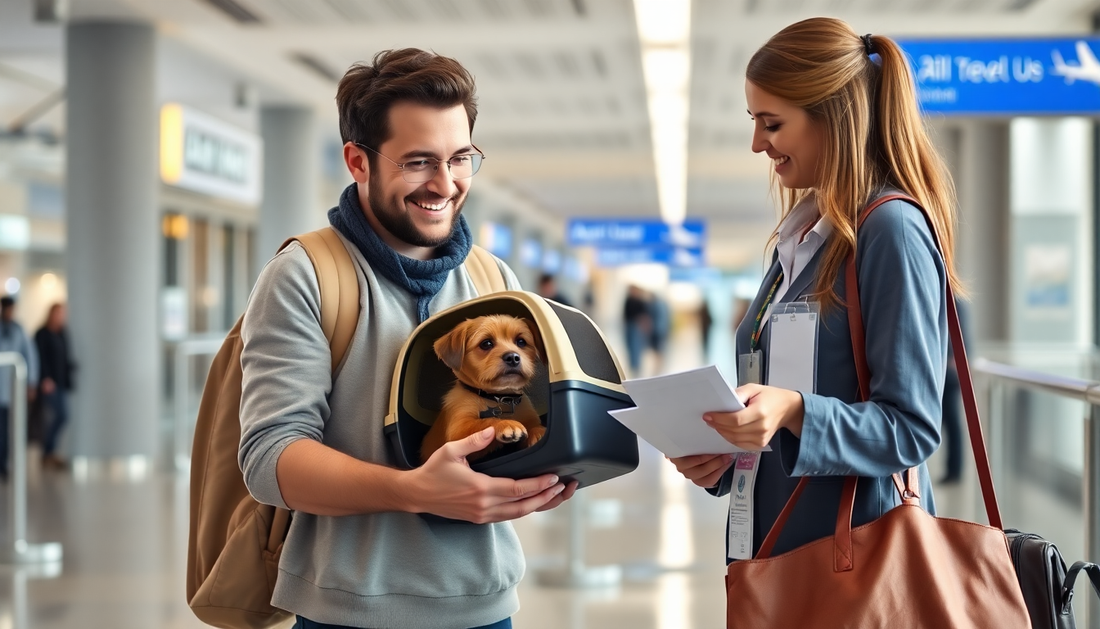
The Ultimate Guide to Flying Safely with Your Pet
Share
As a pet owner, the thought of flying with your furry companion can be both exciting and daunting. Whether you're relocating across the country or embarking on a much-needed vacation, ensuring your pet's safety and comfort during air travel is of utmost importance. In this comprehensive guide, we'll explore the essential steps to make your pet's journey a smooth and stress-free experience.
Pre-Flight Preparation
Before you even step foot in the airport, it's crucial to ensure your pet is ready for the journey ahead. Start by scheduling a veterinary checkup to ensure your pet is in good health and up-to-date on all necessary vaccinations. Obtain any required documentation, such as a health certificate, and make sure your pet's microchip or identification tag is up-to-date.
Next, select an appropriate pet carrier that meets your airline's specific requirements. Consider factors like size, ventilation, and comfort to ensure your furry friend can travel safely and comfortably. If your pet is prone to anxiety, you may want to introduce the carrier well in advance and use it as a familiar and positive space.
Choosing the Right Travel Method
When it comes to flying with your pet, you'll need to decide between in-cabin or cargo travel. In-cabin travel allows your pet to remain with you throughout the flight, while cargo travel means your pet will be transported in the aircraft's hold. Each option has its own set of considerations, such as weight and size restrictions, airline policies, and potential stress levels for your pet.
Carefully research your airline's pet travel policies and make an informed decision based on your pet's needs and the specific requirements of your journey. Keep in mind that some airlines may have limited in-cabin pet spaces, so it's essential to book your pet's travel well in advance.
Pet Carrier Requirements
Regardless of whether your pet is traveling in-cabin or in the cargo hold, you'll need to ensure that their carrier meets the airline's compliance guidelines. Soft-sided carriers are often preferred for in-cabin travel, as they offer more flexibility in terms of size and can be stowed under the seat in front of you. Hard-sided carriers, on the other hand, may be better suited for cargo travel, as they provide more protection and security.
When selecting a carrier, pay close attention to the ventilation, comfort, and accessibility features. Your pet should be able to stand up, turn around, and lie down comfortably within the carrier. Additionally, make sure the carrier is clearly labeled with your pet's name, your contact information, and any necessary travel documentation.
Managing Pet Anxiety
Air travel can be a stressful experience for pets, and it's essential to take steps to minimize their anxiety. Begin by introducing your pet to the carrier well in advance, allowing them to become comfortable with the space. You can also try calming techniques, such as pheromone diffusers or anxiety-reducing supplements, to help your pet stay relaxed during the journey.
On the day of travel, pack familiar comfort items, such as their favorite toy or blanket, to help soothe your pet. Avoid feeding your pet immediately before the flight, as this can exacerbate motion sickness. Instead, offer small, frequent meals and plenty of water to keep your pet hydrated and calm.
Airport Navigation
Navigating the airport with your pet can be a daunting task, but with a little preparation, it can be a smooth process. Upon arrival at the airport, check in with your airline and follow their specific instructions for pet check-in procedures. Be prepared to present any required documentation and ensure your pet's carrier is properly labeled.
During the security screening process, you may be asked to remove your pet from the carrier for inspection. Remain calm and cooperative, and be sure to keep your pet on a leash or in a secure carrier at all times. Many airports also offer designated pet relief areas, so be sure to familiarize yourself with their location and use them as needed.
During the Flight
Once you're on the plane, your focus should be on keeping your pet comfortable and calm. If your pet is traveling in the cabin, make sure they remain in their carrier throughout the flight, and avoid letting them out, as this can be disruptive to other passengers. Offer small amounts of water and familiar treats to help your pet stay hydrated and content.
If your pet is traveling in the cargo hold, be sure to communicate with the airline staff about your pet's needs and any special instructions. Provide the airline with your contact information and a detailed travel plan, in case they need to reach you during the flight.
Post-Flight Care
After the flight, it's important to assess your pet's well-being and help them adjust to their new surroundings. Carefully observe your pet for any signs of stress or discomfort, and be prepared to seek veterinary attention if necessary. Provide your pet with a quiet, familiar space to rest and recover, and gradually reintroduce them to their normal routine.
Remember, every pet is unique, and what works for one may not work for another. Be patient, flexible, and attentive to your pet's needs throughout the entire travel experience. With proper planning and preparation, you can ensure your pet's safe and comfortable journey, allowing you both to enjoy the adventure ahead.
Conclusion
Flying with your pet can be a rewarding and enriching experience, but it requires careful planning and attention to detail. By following the guidelines outlined in this comprehensive guide, you can help ensure your furry companion's safety and well-being during air travel. Remember, the key to a successful pet-friendly flight is thorough preparation, attention to your pet's needs, and a commitment to their comfort and security. With these tips in mind, you and your Furry Buddy can embark on your next adventure with confidence and peace of mind.
